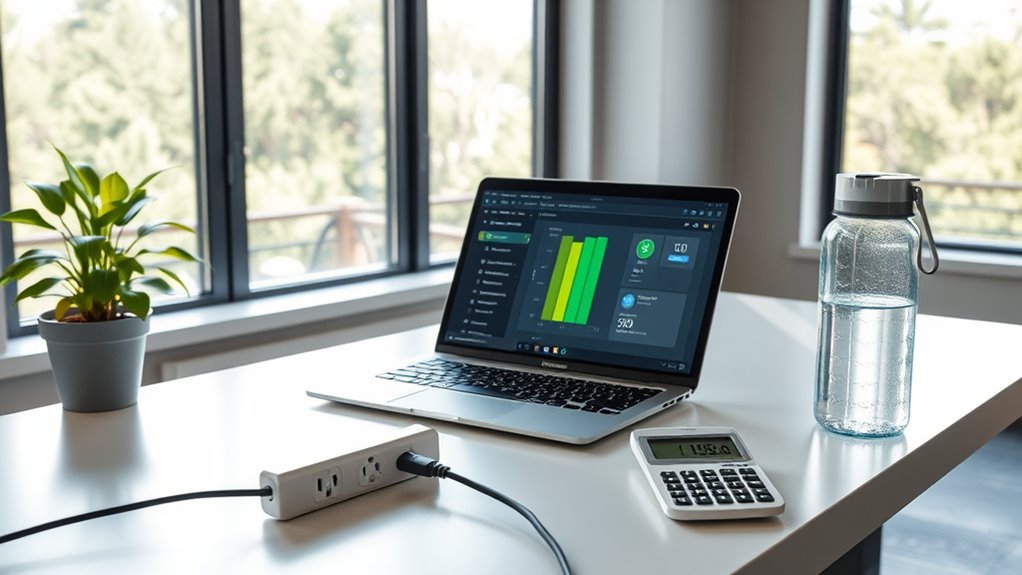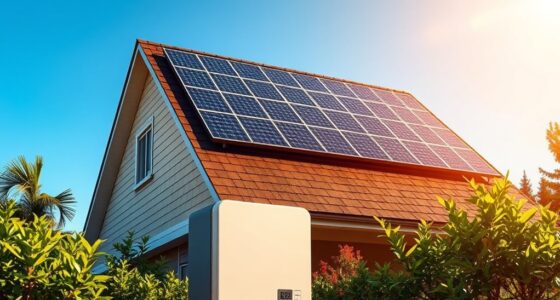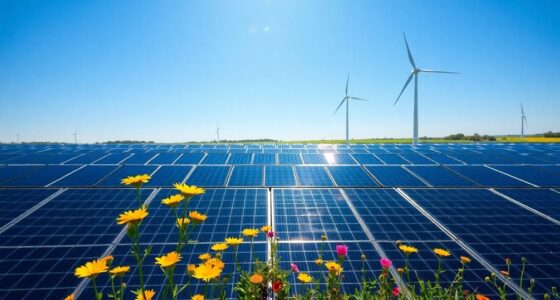To upgrade your tech sustainably, start by choosing energy-efficient devices like ENERGY STAR appliances. Optimize your settings to save energy, and extend lifecycles with proper maintenance. Embrace cloud computing for cost and energy savings, and promote responsible disposal by recycling old tech. Educate your team on sustainable practices to enhance workplace culture. Lastly, advocate for eco-friendly tech initiatives in your community. There’s more to explore on how to make your upgrades even more sustainable.
Key Takeaways
- Choose energy-efficient devices like ENERGY STAR appliances to reduce energy and water consumption significantly.
- Implement device lifecycle management practices to extend the usability of your tech assets.
- Embrace cloud computing and virtualization to lower costs and carbon emissions while optimizing resources.
- Promote responsible disposal and recycling of old electronics to minimize e-waste and its environmental impact.
- Educate employees on sustainable practices and encourage their engagement in tech upgrades for a greener future.
Choose Energy-Efficient Devices

When you choose energy-efficient devices, you’re not just making a smart financial decision; you’re also contributing to a healthier planet.
Energy-efficient refrigerators use 40% to 50% less energy than standard models, while ENERGY STAR certified dishwashers save 12% energy and 30% water. Additionally, selecting energy-efficient heat pumps can lead to significant savings on your energy bills. These appliances are often equipped with smart home device integration, allowing for enhanced control and efficiency. Incorporating solar charge controllers can further optimize energy usage in your home systems.
Opting for front-load washers can cut energy use by 45% and water consumption by 50%. Energy-efficient appliances can significantly reduce greenhouse gas emissions, contributing to a cleaner environment.
Heat pump dryers are also more efficient, using about 20% less energy than traditional models.
Modern air conditioners come with improved insulation and smart thermostat compatibility, enhancing their efficiency.
By selecting these appliances, you’ll lower your monthly bills and reduce your environmental impact.
Energy-efficient devices offer significant savings, making them a smart choice for your home and the earth.
Optimize Settings for Energy Savings

Choosing energy-efficient devices is just the beginning of your journey toward sustainable tech. To maximize your energy savings, optimize your device settings.
Maximizing energy savings starts with optimizing your device settings after choosing energy-efficient technology.
Enable power management features on computers and monitors so they can enter low power modes when not in use. This not only saves energy but also extends battery life in portable devices. Smart plugs enable scheduled turn-off of devices to prevent power draw during off-hours, making them a great addition to your energy-saving strategy. Advance directives can guide decisions on technology investments that align with sustainable practices. Implementing solar energy solutions can also enhance your overall energy efficiency by utilizing renewable resources. Additionally, consider upgrading to energy-efficient heat pumps that can reduce energy bills by up to 50%.
Use the ENERGY STAR Computer Power Management Savings Calculator to see how much energy you might waste if you disable these settings.
For smart devices, adjust default settings to match your lifestyle needs and program them to turn off when not in use.
Regularly review your energy consumption data to identify inefficiencies and make necessary adjustments, ensuring you’re getting the most from your tech while saving energy.
Extend Device Lifecycles

To ensure your tech investments last longer, focus on extending device lifecycles through proper maintenance and strategic planning. Regular updates and security checks not only enhance efficiency but also protect against emerging threats. Implementing device lifecycle management practices can streamline your approach to extending the usability of your tech assets. Additionally, maintaining a clear budget for tech upgrades can help prevent overspending on unnecessary replacements.
Leveraging predictive analytics can also help you forecast potential maintenance needs and optimize your upgrade schedule. Don’t overlook device repairs; they’re essential for preventing premature replacements. Conducting thorough audits helps you manage inventory accurately and identify obsolete devices before they become a burden. Incorporating analytics tools can further enhance your ability to track device performance and anticipate future upgrades.
Establish strong vendor relationships to negotiate better deals and lower procurement costs, while predictive maintenance can help you spot issues before they escalate. Implementing a comprehensive maintenance schedule keeps devices running smoothly and reduces unexpected failures, ultimately supporting your sustainability goals.
Embrace Cloud Computing and Virtualization

As organizations seek to enhance efficiency and sustainability, embracing cloud computing and virtualization emerges as a powerful solution.
By migrating to public clouds, you can cut your total cost of ownership by 30-40%, while enjoying instant scalability that reduces idle resources. This shift can lower carbon emissions by up to 84% and energy consumption by 64%. Additionally, the global cloud computing market is projected to surpass $1 trillion by 2028, indicating the growing importance of cloud solutions for businesses. Furthermore, advancements in renewable energy technologies are expected to complement cloud computing’s sustainability goals. As the demand for AI ethicist jobs increases, organizations are recognizing the need for ethical considerations in their technological advancements. Regular maintenance of cloud infrastructures can further ensure appliance longevity, enhancing overall efficiency.
Migrating to public clouds can reduce costs by 30-40% while significantly lowering carbon emissions and energy consumption.
Virtualization further optimizes resources, allowing multiple virtual machines to run on a single server, which also reduces infrastructure costs.
You’ll experience improved agility with quick setup of new environments and easier maintenance through centralized management.
Plus, cloud service models like IaaS, PaaS, and SaaS offer the flexibility you need to control your infrastructure and applications effectively.
Promote Responsible Disposal and Recycling

While embracing cloud computing and virtualization significantly reduces waste and enhances operational efficiency, it’s equally important to focus on responsible disposal and recycling of electronic devices.
Did you know that less than 25% of electronic waste in the US is recycled? The rest ends up in landfills or is incinerated, causing pollution and wasting valuable resources. By recycling just one million laptops, you can save enough energy to power over 3,500 homes annually. Support your local e-waste regulations, as twenty-five states have specific laws addressing this issue. Additionally, remember that repairing electronics can often extend their lifespans and minimize the need for disposal. Furthermore, freshly squeezed juices contain more nutrients and can be a healthier choice when considering food waste management. Moreover, understanding cookie preferences can help users manage their online presence and minimize digital waste. Transitioning to renewable energy sources can also reduce the environmental impact associated with electronic waste disposal.
Educate Employees on Sustainable Practices

Educating employees on sustainable practices not only fosters a greener workplace but also strengthens the overall corporate culture.
When you prioritize sustainability training, you can expect a 25% increase in employee retention, driving job satisfaction and engagement. By aligning training with your company’s strategic vision, you enhance commitment to environmental and social goals, ultimately improving corporate culture. Sustainability training helps organizations signal their commitment to values important to employees, further enhancing engagement and reducing turnover. Additionally, incorporating continuous learning into your training programs can further empower employees to embrace sustainable practices. Furthermore, understanding production quantity variance can assist teams in making informed decisions about resource consumption and waste reduction. Moreover, building a culture of risk-taking encourages employees to innovate and develop new sustainable solutions.
Clear communication about sustainability initiatives is crucial; it helps employees feel involved and valued. You can further boost participation through interactive training sessions and by offering incentives for sustainable practices.
Advocate for Sustainable Tech Initiatives

Advocating for sustainable tech initiatives can significantly transform your organization’s impact on the environment. Start by implementing biodegradable materials and promoting recycling programs to reduce waste. Encourage the development of eco-friendly devices that utilize sustainable materials and minimize packaging waste. Embrace renewable energy sources and invest in energy-efficient data centers to lower carbon emissions, as data centers are major energy consumers. Utilizing renewable energy sources like wind and solar for powering these initiatives can further enhance sustainability efforts. Additionally, consider integrating technologies like geothermal heat pumps that utilize the Earth’s stable temperature for efficient heating and cooling, which can achieve efficiencies often exceeding 300%. Foster a circular economy by supporting reuse and refurbishing models, and design products with sustainability in mind. Engage stakeholders across sectors to create just and equitable tech deployments. Launch public awareness campaigns to inform communities about sustainable tech benefits. By championing these initiatives, you not only enhance your organization’s sustainability but also inspire others to join the movement for a greener future.
Frequently Asked Questions
How Can I Identify Energy-Efficient Devices While Shopping?
When you’re shopping for energy-efficient devices, start by looking for the ENERGY STAR certification, which guarantees high efficiency.
Check EPEAT ratings for electronics that meet sustainability standards.
Don’t forget to read Energy Guide labels for insights on energy consumption and costs.
Research product reviews to see how others experience performance.
Finally, compare energy usage between different models to make an informed choice that saves energy and money in the long run.
What Are the Environmental Benefits of Refurbishing Old Devices?
Refurbishing reduces waste and revives resources.
When you choose to refurbish old devices, you’re cutting down on electronic waste and minimizing landfill overflow. It also decreases chemical pollution and lowers carbon emissions, making your environmental footprint lighter.
Plus, you’re conserving raw materials and promoting a circular economy.
How Do I Find a Reliable E-Waste Recycling Service?
To find a reliable e-waste recycling service, start by looking for certified recyclers, such as those recognized by NAID or e-Stewards.
Use online directories like Earth911 to locate facilities near you. Ensure they comply with local regulations and have transparent processes for material management.
Check for secure data destruction services and their approach to handling hazardous components.
Lastly, consider their commitment to sustainable practices and community involvement for added assurance.
Can Software Updates Improve the Sustainability of My Devices?
Imagine your device humming efficiently, its lifespan extended while you sip coffee, knowing you’ve made a sustainable choice.
Yes, software updates can significantly improve your devices’ sustainability. They optimize performance, reduce energy consumption, and enhance security, allowing you to keep your hardware longer.
By integrating proactive design and energy-efficient coding, these updates minimize e-waste and support a greener future.
What Are the Advantages of Remote Work for Sustainability?
Remote work offers significant advantages for sustainability.
You reduce carbon emissions by eliminating daily commutes and minimizing office energy use. It also lowers resource consumption, leading to less waste and cleaner air.
By using energy-efficient devices and natural lighting at home, you contribute to energy savings.
Plus, the shift to virtual meetings cuts down on business travel, further decreasing your carbon footprint.
Conclusion
By upgrading your tech sustainably, you’re not just saving the planet—you’re becoming a superhero in the fight against climate change! Every energy-efficient device and every responsible disposal decision you make sends ripples of positive change through the universe. You’ll be the envy of your peers as you embrace cloud computing and educate others on eco-friendly practices. So, go ahead and wield your sustainable tech powers; the Earth is counting on you to lead the charge!









